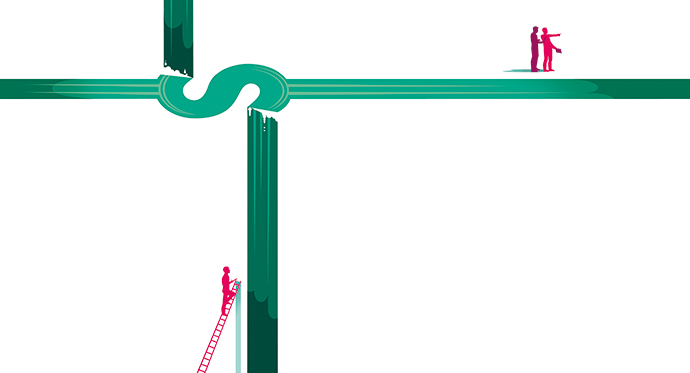
By Adriana Z. Robertson, Assistant Professor, Faculty of Law / Illustration by Daria Kirpach
From the Fall/Winter 2017 issue of Nexus
Over dinner at the Canadian Economics Association meeting last June, one of the other economists at the conference asked me what I study. When I answered “law and finance,” he looked at me quizzically, and asked “is there much to study there?”
While law and economics is, at this point, decidedly mainstream, law and finance remains more of a niche. As my interlocutor and I continued to speak, I realized that what had become second nature to me was perhaps not as obvious to the wider world. While the fields of law and finance are clearly distinct, they are also deeply intertwined. I have come to believe that in many instances, to study one without the other is to miss half the story.
One way to think about law and finance is to imagine a river. We have some general principles that help us predict how the water will flow. For example, all rivers flow downhill, and generally end up, sooner or later, in one of the world’s five oceans. At the same time, a whole host of other factors—soil density, rock formations, even vegetation—will have a substantial impact on the river’s trajectory. That river is finance.
Now imagine that you would like to control the flow of the river. Perhaps you would like to reduce the risk of flooding in adjacent areas, or to divert some of the water to an artificial canal. At the extreme, you may be trying to reverse the flow of the river entirely. To do so, you construct enormous amounts of infrastructure – canals, levees, dams, etc. That infrastructure is law.
Suppose—rather naïvely—that you simply block off part of the river (say with a dam). The river isn’t just going to stop flowing. Instead, it will find somewhere else to go, and that new route might be even worse than the old one. While you may have succeeded in damming the river, you may also find that you have flooded a town 20 kilometers away.
In the end, law and finance is, to me, about thinking through the relationship between the river and the infrastructure that surrounds it. One set of questions concerns the implications of the current infrastructure on the river’s flow. For example, in a recent project, I studied the details of how credit card securitization programs were structured to discover how the programs’ sponsors were able to, very quietly, bail out their programs during the 2008 financial crisis. It turns out that the infrastructure – the legal entities and governing documents associated with these programs – were far more flexible than had been previously thought by experts in this area. As a result of this flexibility, the programs were able to weather the crisis in a way that benefited all parties. In this case, not only was the relevant infrastructure erected by private parties rather than by governmental entities, it was used in ways that had not been previously contemplated.
Another set of questions concerns how changes in the infrastructure affect the flow of the river. For example, in another project, I investigated the effect of a rule change by the United States Securities and Exchange Commission. This rule change was based on prevailing theories of “efficient capital markets,” and was intended to make it easier for large companies to raise money while at the same time maintaining protections for investors. In studying this rule change, I found evidence that companies were able to take advantage of the rule change in unexpected ways.
A third set of questions concerns what additional infrastructure might be useful in improving the river. This third set of questions is both the hardest to answer, and is the most important. For example, in a new project, my colleague Professor Anita Anand and I are investigating the role of securities indices in modern financial markets. While these indices play an incredibly important role in shaping investing decisions, they have been almost entirely overlooked by the law. As a part of our research, we hope to develop suggestions for how these critically important pieces of financial infrastructure can be improved.
I don’t know whether or not I succeeded in persuading my interlocutor that law and finance is more than an obscure subfield. But I do know that in reflecting on our conversation, I have come to a richer understanding of my own scholarly field. And that is far more important to me than convincing a single skeptic.
Professor Robertson holds a BA from the University of Toronto, Trinity College, where she was awarded the Lorne T. Morgan Gold Medal in Economics. A graduate of Yale Law School, she was on the board of the Yale Journal on Regulation and the Yale Journal of Law and Feminism. She received her PhD in Finance from the Yale School of Management in December 2017.
By Adriana Z. Robertson, Assistant Professor, Faculty of Law


